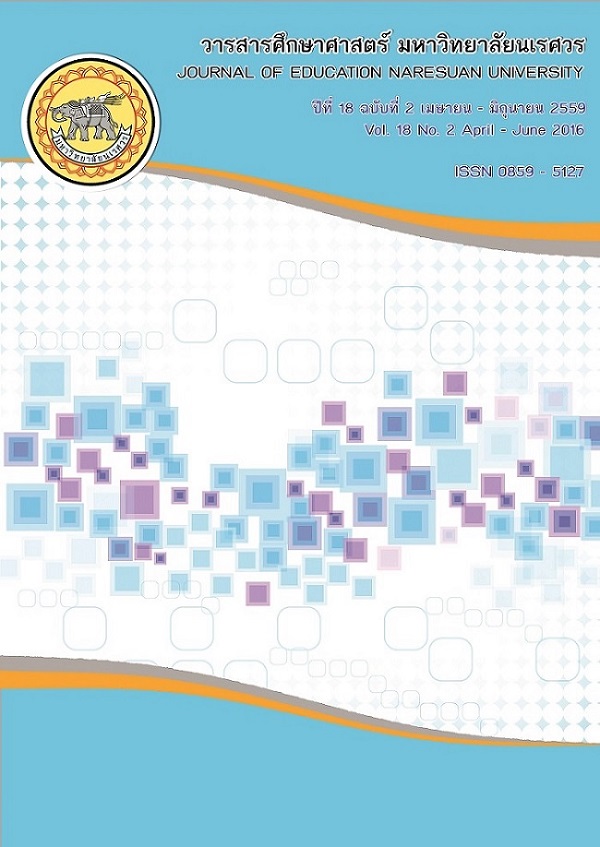การศึกษาผลการจัดการเรียนรู้แบบเชิงรุก วิชาเคมี เรื่อง อนุพันธ์ของสารประกอบไฮโดรคาร์บอน สำหรับนักเรียนชั้นมัธยมศึกษาปีที่ 6
Main Article Content
Abstract
บทคัดย่อ
การศึกษาวิจัยครั้งนี้มีวัตถุประสงค์เพื่อ 1) เปรียบเทียบผลสัมฤทธิ์ทางการเรียนวิชาเคมีและการคิดวิเคราะห์ในวิชาเคมี เรื่อง อนุพันธ์ของสารประกอบไฮโดรคาร์บอน ระหว่างการจัดการเรียนรู้แบบเชิงรุกกับการจัดการเรียนรู้แบบสืบเสาะ 2) เปรียบเทียบผลสัมฤทธิ์ทางการเรียนวิชาเคมีและการคิดวิเคราะห์ในวิชาเคมี เรื่อง อนุพันธ์ของสารประกอบไฮโดรคาร์บอน ก่อนเรียนและหลังเรียนด้วยการจัดการเรียนรู้แบบเชิงรุก และ 3) ศึกษาเจตคติต่อวิชาเคมีหลังเรียนด้วยการจัดการเรียนรู้แบบเชิงรุก กลุ่มตัวอย่างที่ใช้ในการวิจัยคือ นักเรียนชั้นมัธยมศึกษาปีที่ 6 โรงเรียนพนัสพิทยาคาร จังหวัดชลบุรี ด้วยวิธีการสุ่มแบบกลุ่ม (cluster random sampling) โดยกลุ่มที่ 1 จำนวน 42 คน สอนด้วยวิธีการจัดการเรียนรู้แบบเชิงรุก และกลุ่มที่ 2 จำนวน 45 คน สอนด้วยวิธีการจัดการเรียนรู้แบบสืบเสาะ เครื่องมือที่ใช้ในการวิจัยได้แก่ 1) แผนการจัดการเรียนรู้วิชาเคมีโดยใช้การจัดการเรียนรู้แบบเชิงรุก 2) แผนการจัดการเรียนรู้วิชาเคมีโดยใช้การจัดการเรียนรู้แบบสืบเสาะ 3) แบบทดสอบวัดผลสัมฤทธิ์ทางการเรียนรู้วิชาเคมี มีค่าความเชื่อมั่น 0.85 4) แบบทดสอบวัดการคิดวิเคราะห์ในวิชาเคมี มีค่าความเชื่อมั่นเท่ากับ 0.85 5) แบบวัดเจตคติต่อวิชาเคมี มีค่าความเชื่อมั่น 0.88 วิเคราะห์ข้อมูลโดยใช้ค่าเฉลี่ย ส่วนเบี่ยงเบนมาตรฐาน สถิติการทดสอบที (t-test)
ผลการวิจัย พบว่า
1. ผลสัมฤทธิ์ทางการเรียนวิชาเคมีของนักเรียนที่ได้รับการจัดการเรียนรู้แบบเชิงรุกสูงกว่า นักเรียนที่ได้รับการจัดการเรียนรู้แบบสืบเสาะอย่างมีนัยสำคัญทางสถิติที่ระดับ .05
2. การคิดวิเคราะห์ในวิชาเคมีของนักเรียนที่ได้รับการจัดการเรียนรู้แบบเชิงรุกสูงกว่า นักเรียนที่ได้รับการจัดการเรียนรู้แบบสืบเสาะอย่างมีนัยสำคัญทางสถิติที่ระดับ .05
3. ผลสัมฤทธิ์ทางการเรียนวิชาเคมีของนักเรียน หลังเรียนด้วยการจัดการเรียนรู้แบบเชิงรุก สูงกว่าก่อนเรียนอย่างมีนัยสำคัญทางสถิติที่ระดับ .05
4. การคิดวิเคราะห์ในวิชาเคมีของนักเรียน หลังเรียนด้วยการจัดการเรียนรู้แบบเชิงรุก สูงกว่าก่อนเรียนอย่างมีนัยสำคัญทางสถิติที่ระดับ .05
5. เจตคติต่อวิชาเคมีหลังเรียนของนักเรียนที่ได้รับการจัดการเรียนรู้แบบเชิงรุก อยู่ในระดับดี
คำสำคัญ: การจัดการเรียนรู้แบบเชิงรุก, การจัดการเรียนรู้แบบสืบเสาะ
A STUDY ON THE EFFECTS OF ACTIVE LEARNING METHOD IN HYDROCARBON DERIVATIVES FOR GRADE 12 STUDENTS
The purposes of this research were: 1) To compare learning achievement and analytical thinking on the topic of hydrocarbon derivatives between active learning method and the inquiry method, 2) To compare learning achievement and analytical thinking on the topic of hydrocarbon derivatives before and after learning with active learning method, and 3) To study attitude in chemistry after learning by active learning method with the criteria at a good level. The samples used in the research for grade 12 students from Phanatpittayakarn School, Chonburi province, selected by cluster random sampling. The first group of 42 students was taught by active learning method and the second group of 45 students was taught by inquiry method. The research instruments were: 1) Active learning lesson plan, 2) the inquiry lesson plan, 3) chemistry learning achievement test that showed a reliability of 0.85, 4) the analytical thinking test in chemistry that showed a reliability of 0.85, and 5) attitude test in chemistry that showed a reliability of 0.88. The data were analyzed by using mean, standard deviation and t-test.
The results of this study indicate that:
1. The chemistry learning achievement of the students taught by active learning method is higher than those who learn by the inquiry method with a statistically significantce at the .05 level.
2. The analytical thinking in chemistry of the students taught by active learning method is higher than those who learn by the inquiry method with a statistically significantce at the .05 level.
3. The chemistry learning achievement of the students taught by active learning method after learning is higher than before learning with a statistically significantce at the .05 level.
4. The analytical thinking in chemistry of the students taught by active learning method after learning is higher than before learning with a statistically significantce at the .05 level.
5. Student attitude relating chemistry after learning by active learning method was at a good level.
Keywords: Active Learning, Inquiry Learning
Article Details
The owner of the article does not copy or violate any of its copyright. If any copyright infringement occurs or prosecution, in any case, the Editorial Board is not involved in all the rights to the owner of the article to be performed.


